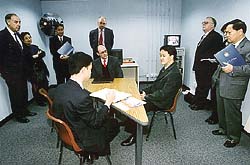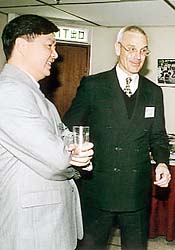



















 PRO Roger Stoker and CIP Ma Ping-yiu demonstrate for members of the Criminal Court Users Committee a mock police interview of a suspect in one of the Force's 60 state-of-the-art video interview rooms. The efforts of both CIP Ma and Mr Stoker were instrumental in delivering the new rooms on time and within budget |
LAST month the Criminal Court Users Committee
paid a visit to Police Headquarters where, as guests of D C&S Lau Yuk-kuen and CSP, Crime
Support, John Bicknell, they were given a demonstration of a mock police interview of a
suspect in the state-of-the-art OCTB video interview room in Crime Headquarters. The facility
is just one of the 60 newly designed and refurbished video interview rooms now fully
operational in most major divisional stations as well as bureaux, headquarters and regional
crime units of the Force °–and which have proven to be instrumental in winning criminal
cases in Court.
The Committee°–comprised of High Court Justices, District Judges, Chief Magistrates, as well as representatives of the Law Society, the Department of Justice, Legal Aid, the Duty Lawyer Service, Judiciary, and Judicial Clerks °–liked what they saw. The whole idea behind the openness and transparency of the new video interview rooms is to preserve the rights of those being interviewed, while at the same time ensuring that the police interview process (and in turn the Court process) runs as smoothly, fairly, openly and efficiently as possible. |
|
The new video interview rooms are the result of years of development, improvement, procedural training and technological evolution. Video recording of suspect interviews by Hong Kong Police began in 1993 with a pilot project comprising one video interview room set up in the Organised Crime and Triad Bureau of the old Causeway Bay Police Station. Back then, officers used a single video camera and microphone linked to three household video decks that had to be turned on individually. The room resembled the set of a bad detective movie, the video image was fuzzy and the sound muffled. But even with those drawbacks, the effect in court was electric. Judges and jurors saw suspects confessing to serious crimes on tape. Cameras don't lie. The impact was obvious. The video interview room process also led to no evidential loss as the tape reveals the voice intonation and facial expression of the suspect and interviewer. Because no text is prepared by officers, areas for argument on accuracy, interpretation and bias are eliminated. At the same time, the interviewing officer (free from having to take notes) can create a rapport with the suspect, and in turn an atmosphere conducive to open dialogue and confession. Another advantage of the video statement is that the interviewee is seen throughout giving his or her statement thus eliminating claims of duress, tiredness, misunderstanding, police intimidation or brutality. In 1996 the project was reviewed and video interview rooms accepted as the way forward. By the end of 1997 the number of video interview rooms had expanded to 11 with an increased degree of technical sophistication. Funding was granted for more, and to bring the rooms up to a uniform standard. "When the decision was made to develop high quality video interview rooms with the same design, layout and technical equipment, it was also decided, in terms of geographical coverage, that 60 rooms Force-wide were needed to ensure that in multiple suspect cases, or a serious arrest involving a suspect who wanted to confess, officers were only minutes away from a video interview room,” explained Police Research Officer Roger Stoker, who was then tasked to meet the design, technical and equipment requirements of the rooms. "It was very difficult and exacting work but it's wonderful to look back and see the project completed on time, within budget and to the high standard we wanted,"” said Mr Stoker. Force co-ordinator for the project was CIP, Crime Headquarters, Ma Ping-yiu, whose main job was to ensure that the high standards of the rooms, once found and designated for use, were achieved. As such, it was necessary to deal with a variety of government departments responsible for refurbishing the rooms and tendering the equipment, then attending the sites to supervise the work of the contractors. "We were given a year to complete the project, so the schedule was very tight. But we made our deadline °– which was the end of 1998. Especially satisfying has been the positive feedback from officers who have used the rooms,"” said CIP Ma. Adding to the total transparency of the process, the interview is simultaneously recorded on three video tapes employing high-tech, high-quality, tamperproof equipment that is simple to operate. At the interview's conclusion, one of the tapes is sealed in the interviewee's and his or her legal representative's presence to be kept securely in case it is needed in future Court proceedings. The second tape is retained by police as a working copy, and the third given to the interviewee's legal representative (if present). "So you can see how the officer behaved, how the defendant behaved, and how the legal advisor behaved while all of this was going on,"” said Mr Stoker. "More to the point, you can be sure that the tape has not been tampered with because it was placed in the recorder with everyone there, recorded while they were there, taken out and sealed while they were there, then immediately presented to the defence. The avenues for legal argument are considerably reduced." Continued Mr Stoker: "The new video interview rooms have a specification which is substantially different from that used in the past. Under the new specification the Force can demonstrate conclusively that the content of the tapes to be presented as the record of interview are both unaltered and unedited. They also contain a magnetically imprinted record of the time and place of the interview. To preclude concerns that the copies passed to suspects might be used to identify and target interviewing officers by serious criminals, twin cameras place only the suspect and his or her counsel on the defence tape. While the new system places different images on the police/defence tapes, the sound track is common to both as are the anti-tampering features. This all serves to further increase transparency and the admissibility of confession statements." Additionally, very efficient dual microphones ensure that the whole sound-proofed room picks up all that is said with clarity. For added security each of the 60 video interview rooms has a small monitoring room adjacent to it which is manned by police personnel scrutinising the interview while in session. At last count, about 500 officers at inspectorate level and over 2,000 junior police officers have been trained in the use of video interview rooms and interview techniques. Challenges of video tape testimonies in Court are down from 90 per cent to 15 per cent. To date, of the 1,200 statements taken in these rooms, less than 15 per cent were challenged by voir dire, and only half a per cent of the total were ruled inadmissible in a court of law. On the other hand, the challenge-rate of written statements have been up as high as 90 per cent. As the expansion of the rooms has increased so have the number of statements recorded in video interview rooms due to the increased availability, relaxation on case restrictions for use, and greater admissibility of content. One key drawback of the process had been the issue of transcription, i.e. the length of the video taped interviews. Which is why feedback and direction from the Criminal Court Users Committee has been of such great value to police. "What they want is a synopsis," said Mr Stoker. "Which would be something to the effect: There were 15 minutes of rapport building, then from minute number 23 to minute number 27 the suspect made certain admissions, namely . . . After which the transcription would be verbatim. That could go to defence council for comparison with the tape. Likewise with our prosecutors. If they are all in agreement the issue is resolved." | |
| SAID LAST week Police
Public Relations Branch staff threw a farewell party for CSP PPRB Harry Blud, while at the
same time celebrating his recommended promotion to the rank of Assistant Commissioner
of Police.
Mr Blud, who has since taken up his new post as head of the Service Quality Wing, served in PPRB for almost three years and helped guide it through one of the most momentous and crucial periods in the history of the Force and Hong Kong °– the transition of sovereignty in 1997. A 32-year veteran of the Force, Mr Blud's direction of PPRB played an important and vital role in projecting the positive, "business as usual"image of the Hong Kong Police Force throughout the transitional period to members of both local and international press °– which in turn helped to reflect the reality of stability in Hong Kong. |  CSP Blud and SSP Fung at a recent "meet the press" gathering at PPRB |
|
Well-known for his sometimes acerbic letters to the editor of Hong Kong newspapers, Mr Blud was always quick to set the record straight in his defence of Force policy and matters concerning the police. Under his tenure PPRB produced the award winning promotional video Force of the Future, as well as a series of well-received and lauded television commercials. He also oversaw the improvement of the Force television shows, Police Report and Police Magazine, revamped the now bilingual Force Homepage on the Internet, and helped to repackage and redesign the 1997 Police Review, which was commended in the 1998 Hong Kong Management Association Best Annual Reports Awards. Replacing Mr Blud as head of PPRB will be SSP Crime, KW, Fung Kin-man. | |

